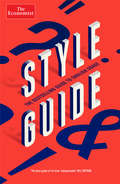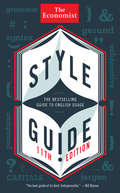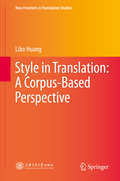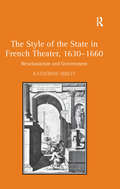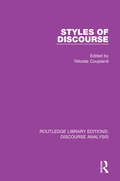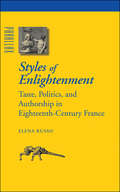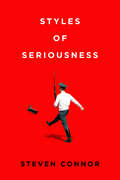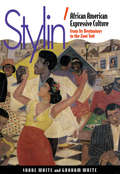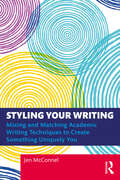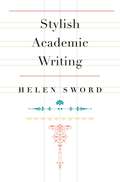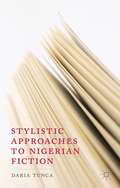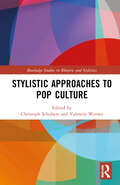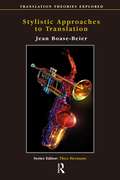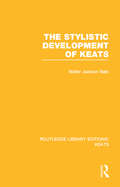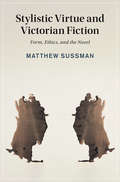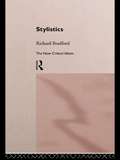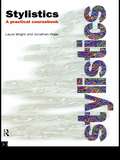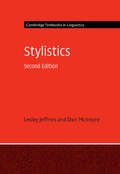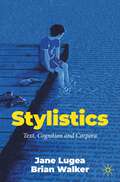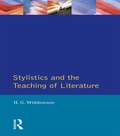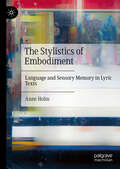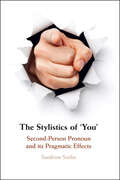- Table View
- List View
Style Guide (Economist Books)
by The EconomistThis expanded twelfth edition of the bestselling guide to style is based on The Economist's own updated house style manual, and is an invaluable companion for everyone who wants to communicate with the clarity, style and precision for which The Economist is renowned.As the introduction says, 'clarity of writing usually follows clarity of thought.'The Economist Style Guide gives general advice on writing, points out common errors and clichés, offers guidance on consistent use of punctuation, abbreviations and capital letters and contains an exhaustive range of reference material--covering everything from accountancy ratios and stock market indices to laws of nature and science.Some of the numerous useful rules and common mistakes pointed out in the guide include:Which informs, that defines. This is the house that Jack built. But: This house, which Jack built, is now falling down.Discreet means circumspect or prudent; discrete means separate or distinct. Remember that "Questions are never indiscreet. Answers sometimes are" (Oscar Wilde).Flaunt means display, flout means disdain. If you flout this distinction you will flaunt your ignorance.Forgo means do without; forego means go before.Fortuitous means accidental, not fortunate or well-timed.Times: Take care. Three times more than X is four times as much as X.Full stops: Use plenty. They keep sentences short. This helps the reader.
Style Guide
by The Economist Newspaper Ltd.This expanded eleventh edition of the bestselling guide to style is based on the Economist's own updated house style manual, and is an invaluable companion for everyone who wants to communicate with the clarity, style and precision for which the Economist is renowned. As the introduction says, 'clarity of writing usually follows clarity of thought. ' The Economist Style Guide gives general advice on writing, points out common errors and clichés, offers guidance on consistent use of punctuation, abbreviations and capital letters, and contains an exhaustive range of reference material - covering everything from accountancy ratios and stock market indices to laws of nature and science. Some of the numerous useful rules and common mistakes pointed out in the guide include: *Which informs, that defines. This is the house that Jack built. But: This house, which Jack built, is now falling down. *Discreet means circumspect or prudent; discrete means separate or distinct. Remember that "Questions are never indiscreet. Answers sometimes are" (Oscar Wilde). *Flaunt means display, flout means disdain. If you flout this distinction you will flaunt your ignorance *Forgo means do without; forego means go before. *Fortuitous means accidental, not fortunate or well-timed. *Times: Take care. Three times more than X is four times as much as X. *Full stops: Use plenty. They keep sentences short. This helps the reader.
Style in Translation: A Corpus-Based Perspective
by Libo HuangThis book attempts to explore style--a traditional topic--in literary translation with a corpus-based approach. A parallel corpus consisting of the English translations of modern and contemporary Chinese novels is introduced and used as the major context for the research. The style in translation is approached from perspectives of the author/the source text, the translated texts and the translator. Both the parallel model and the comparable model are employed and a multiple-complex model of comparison is proposed. The research model, both quantitative and qualitative, is duplicable within other language pairs. Apart from the basics of corpus building, readers may notice that literary texts offer an ideal context for stylistic research and a parallel corpus of literary texts may provide various observations to the style in translation. In this book, readers may find a close interaction between translation theory and practice. Tables and figures are used to help the argumentation. The book will be of interest to postgraduate students, teachers and professionals who are interested in corpus-based translation studies and stylistics.
The Style of the State in French Theater, 1630–1660: Neoclassicism and Government
by Katherine IbbettEngaging with recent thinking about performance, political theory and canon formation, this study addresses the significance of the formal changes in seventeenth-century French theater. Each chapter takes up a particularity of seventeenth-century theatrical style and staging”for example, the clearing of violence from the stage”and shows how the conceptualization of these French stylistic shifts appropriates a rich body of Italian political writing on questions of action, temporality, and law. The theater's appropriation of political concerns and vocabularies, the author argues, proffers an astute reflection on the practices of government that draws attention to questions obscured in reason of state, such as the instrumentalization of women's bodies. In a new reading of tragedies about government, the author shows how the canonical figure of Pierre Corneille is formally engaged with the political strategizing he often appears to repudiate, and in so doing challenges a literary history that has read neoclassicism largely as a display of pure French style.
Styles of Discourse (RLE: Discourse Analysis)
by Nikolas CouplandFirst published in 1988, this book focuses on diversity and discourse, and collects contemporaneous research across a wide range of topics including: description, polemic, narrative analysis, DJ talk, philosophical history, conversation, children’s books and nuclear deterrence. The essays demonstrate analyses of discourse in the service of stylistic inquiry, exploring relationships of text and context. This reflects the overall argument that discourse analyses aiming to represent diversity of social context will necessarily approach the task selectively, since all dimensions are of potential relevance to any and every communicative manifestation. Some of contextual dimensions that are addressed include: interpersonal, socio-structural, modal, ideological, and pragmatic.
Styles of Enlightenment: Taste, Politics, and Authorship in Eighteenth-Century France (Parallax: Re-visions of Culture and Society)
by Elena RussoStyles of Enlightenment argues that alongside its democratic ideals and its efforts to create a unified public sphere, the Enlightenment also displayed a tendency to erect rigid barriers when it came to matters of style and artistic expression. The French philosophes tackled the issue of the hierarchy of genres with surprising inflexibility, and they looked down on those forms of art that they saw as commercial, popular, and merely entertaining. They were convinced that the standard of taste was too important a matter to be left to the whims of the public and the vagaries of the marketplace: aesthetic judgment ought to belong to a few, enlightened minds who would then pass it on to the masses.Through readings of fictions, essays, memoirs, eulogies, and theatrical works by Fénelon, Bouhours, Marivaux, Montesquieu, Voltaire, Diderot, Rousseau, Mercier, Thomas, and others, Styles of Enlightenment traces the stages of a confrontation between the virile philosophe and the effeminate worldly writer, "good" and "bad" taste, high art and frivolous entertainment, state patronage and the privately sponsored marketplace, the academic eulogy and worldly conversation. It teases out the finer points of division on the public battlefields of literature and politics and the new world of contesting sexual economies.
Styles of Seriousness
by Steven ConnorBeing serious demands serious kinds of work. In Styles of Seriousness, Steven Connor reflects on the surprisingly various ways in which a sense of the serious is made and maintained, revealing that while seriousness is the most powerful feeling, it is also the most poignantly indeterminate, perhaps because of the impossibility of being completely serious. In colloquy with philosophers such as Aristotle, Nietzsche, James, Sartre, Austin, Agamben and Sloterdijk, and writers like Shakespeare, Byron, Auden and Orwell, Connor considers the linguistic and ritual behaviors associated with different modes of seriousness: importance; intention, or ways of really "meaning things;" sincerity; solemnity; urgency; regret; warning; and ordeal. The central claim of the book is human beings are capable of taking things seriously in a way that nonhuman animals are not, for the unexpected reason that human beings are so much more versatile than most animals at not being completely serious. One always, in fact, has a choice about whether or not to take seriously something that is supposed to be so. As a consequence, seriousness depends on different kinds of formalization or stylized practice. Styles of seriousness matter, Connor shows, because human beings are incapable of simply and spontaneously existing. Being a human means having to take seriously one's style of being.
The Style's the Man: Reflections on Proust, Fitzgerald, Wharton, Vidal, and Others
by Louis AuchinclossEssays on well-known literary works and artists.
Stylin': African-American Expressive Culture, from Its Beginnings to the Zoot Suit
by Shane White Graham WhiteFor over two centuries, in the North as well as the South, both within their own community and in the public arena, African Americans have presented their bodies in culturally distinctive ways. Shane White and Graham White consider the deeper significance of the ways in which African Americans have dressed, walked, danced, arranged their hair, and communicated in silent gestures. They ask what elaborate hair styles, bright colors, bandanas, long watch chains, and zoot suits, for example, have really meant, and discuss style itself as an expression of deep-seated cultural imperatives. Their wide-ranging exploration of black style from its African origins to the 1940s reveals a culture that differed from that of the dominant racial group in ways that were often subtle and elusive. A wealth of black-and-white illustrations show the range of African American experience in America, emanating from all parts of the country, from cities and farms, from slave plantations, and Chicago beauty contests. White and White argue that the politics of black style is, in fact, the politics of metaphor, always ambiguous because it is always indirect. To tease out these ambiguities, they examine extensive sources, including advertisements for runaway slaves, interviews recorded with surviving ex-slaves in the 1930s, autobiographies, travelers' accounts, photographs, paintings, prints, newspapers, and images drawn from popular culture, such as the stereotypes of Jim Crow and Zip Coon.
Styling Your Writing: Mixing and Matching Academic Writing Techniques to Create Something Uniquely You
by Jen McConnelThis text helps developing writers in the academy and beyond think through their writing process and develop strategies for styling their writing to meet the demands of a wide range of goals. The book imagines writing as an assortment of "outfits"— bundles of styles and strategies through which one approaches a writing purpose, such as writing focused on experimentation and growth or writing focused on a professional task. By assessing the outfits writers feel most and least confident in, and examining how to be more at home in the outfits that matter to them, this book helps students develop both specific skills and their overall identity as writers. Readers are guided through before-, during-, and after-writing strategies and techniques, including: freewriting, outlining, visual planning, and composing in multimodal forms. Readers are also introduced to the importance of setting clear writing goals and sharing their work in a variety of ways, both in preparation for classroom success through peer review and writing center visits, and beyond the classroom in virtual and in-person spaces. This book serves as a core or supplemental text for writing courses at the undergraduate, graduate, or high school level, or as a writing guide for individual readers.
Stylish Academic Writing
by Helen SwordElegant data and ideas deserve elegant expression, argues Helen Sword in this lively guide to academic writing. For scholars frustrated with disciplinary conventions, and for specialists who want to write for a larger audience but are unsure where to begin, here are imaginative, practical, witty pointers that show how to make articles and books a pleasure to read—and to write.Dispelling the myth that you cannot get published without writing wordy, impersonal prose, Sword shows how much journal editors and readers welcome work that avoids excessive jargon and abstraction. Sword’s analysis of more than a thousand peer-reviewed articles across a wide range of fields documents a startling gap between how academics typically describe good writing and the turgid prose they regularly produce.Stylish Academic Writing showcases a range of scholars from the sciences, humanities, and social sciences who write with vividness and panache. Individual chapters take up specific elements of style, such as titles and headings, chapter openings, and structure, and close with examples of transferable techniques that any writer can master.
Stylistic Approaches to Nigerian Fiction
by Daria TuncaDrawing on the discipline of stylistics, this book introduces a series of methodological tools and applies them to works by well-known Nigerian writers, including Abani, Adichie and Okri. In doing so, it demonstrates how attention to form fosters understanding of content in their work, as well as in African and postcolonial literatures more widely.
Stylistic Approaches to Pop Culture (Routledge Studies in Rhetoric and Stylistics)
by Christoph SchubertThis collection showcases the unique potential of stylistic approaches for better understanding the multifaceted nature of pop culture discourse. As its point of departure, the book takes the notion of pop culture as a phenomenon characterized by the interaction of linguistic signs with other modes such as imagery and music to examine a diverse range of genres through the lens of stylistics. Each section is grouped around thematic lines, looking at literary fiction, telecinematic discourse, music and lyrics, as well as cartoons and video games. The 12 chapters analyze different forms of media through five central strands of stylistics, from sociolinguistic, pragmatic, cognitive, multimodal, to corpus-based approaches. In drawing on these various stylistic frameworks and applying them across genres and modes, the contributions offer readers deeper insights into the role of scripted and performed language in social representation and identity construction, thereby highlighting the affordances of stylistics research in studying pop cultural texts. This volume is of particular interest to students and researchers in stylistics, linguistics, literary studies, media studies, and cultural studies.
Stylistic Approaches to Translation (Translation Theories Explored #Vol. 10)
by Jean Boase-BeierThe concept of style is central to our understanding and construction of texts. But how do translators take style into account in reading the source text and in creating a target text? This book attempts to bring some coherence to a highly interdisciplinary area of translation studies, situating different views and approaches to style within general trends in linguistics and literary criticism and assessing their place in translation studies itself. Some of the issues addressed are the link between style and meaning, the interpretation of stylistic clues in the text, the difference between literary and non-literary texts, and more practical questions about the recreation of stylistic effects. These various trends, approaches and issues are brought together in a consideration of the most recent cognitive views of style, which see it as essentially a reflection of mind. Underlying the book is the notion that knowledge of theory can affect the way we translate. Far from being prescriptive, theories which describe what we know in a general sense can become part of what an individual translator knows, thus opening the way for greater awareness and also greater creativity in the act of translation. Throughout the discussion, the book considers how insights into the nature and importance of style might affect the actual translation of literary and non-literary texts.
The Stylistic Development of Keats (Routledge Library Editions: Keats)
by Walter Jackson BateThis study, first published in 1945, gives a precise description of the unfolding of a great poet’s craftsmanship and suggests alignments of the technical progression with the changes of the mind. Metrical analysis is given in order to throw light on Keats’ general stylistic development using the simplest terminology and in a traditional manner. Earlier English prosodic writings are referred to throughout in order to place the style and development in the context of the period. Arranged chronologically, each chapter looks at a particular work or group of works drawing together evidence about Keats’ poetic direction. This classic work from a well-known Keats scholar is an important enlightening contribution within the extensive study of Keats’ poetry and letters.
Stylistic Virtue and Victorian Fiction: Form, Ethics, and the Novel (Cambridge Studies in Nineteenth-Century Literature and Culture #130)
by Matthew SussmanWhat is style, and why does it matter? This book answers these questions by recovering the concept of 'stylistic virtue,' once foundational to rhetoric and aesthetics but largely forgotten today. Stylistic virtues like 'ease' and 'grace' are distinguishing properties that help realize a text's essential character. First described by Aristotle, they were integral to the development of formalist methods and modern literary criticism. The first half of the book excavates the theory of stylistic virtue during its period of greatest ascendance, in the late eighteenth and nineteenth centuries, when belletristic rhetoric shaped how the art of literary style and 'the aesthetic' were understood. The second half offers new readings of Thackeray, Trollope, and Meredith to show how stylistic virtue changes our understanding of style in the novel and challenges conventional approaches to interpreting the ethics of art.
Stylistics (The New Critical Idiom)
by Richard BradfordRichard Bradford provides a definitive introductory guide to modern critical ideas on literary style and stylistics. It will provide students with a basic grasp of stylistics and literary analysis.This comprehensive and accessible guidebook for undergraduates examines:* the terminology of literary form* how literary style has evolved since the sixteenth century* the role of stylistics in twentieth century criticism* the discipline of stylistics from classical rhetoric to post-structuralism* the relationship between literary style and its historical context* style and gender* examples of poems, plays and novels from Shakespeare to the present day.
Stylistics: A Practical Coursebook
by Jonathan Hope Laura WrightUsing a wide range of twentieth-century literary prose Laura Wright and Jonathan Hope provide an `interactive' introduction to the techniques of stylistic analysis. Divided up into five sections; the noun phrase, the verb phrase, the clause, text structure and vocabulary, the book also provides an introduction to the basics of descriptive grammar for beginning students. * Presumes no prior linguistic knowledge * Provides a comprehensive glossary of terms * Adaptable: designed to be used in a variety of classroom contexts * Introduces students to an enormous range of 20th century literature from James Joyce to Roddy Doyle A practical coursebook rather than a survey account of stylistics as a discipline, the book provides over forty opportunities for hands-on stylistic analysis. For each linguistic feature under discussion the reader is offered a definition, a text for analysis, exercises and tasks, in addition to a suggested solution. Stylistics: A Practical Coursebook is genuinely `student friendly' and will be an invaluable tool for all beginning undergraduates and A-level students of language and literature.
Stylistics (Cambridge Textbooks in Linguistics)
by Lesley Jeffries Dan McIntyreStylistics is the linguistic study of style in language. Now in its second edition, this book is an introduction to stylistics that locates it firmly within the traditions of linguistics. Organised to reflect the historical development of stylistics, it covers key principles such as foregrounding theory, as well as recent advances in cognitive and corpus stylistics. This edition has been fully revised to cover all the major developments in the field since the first edition, including extensive coverage of corpus stylistics, new sections on a range of topics, additional exercises and commentaries, updated further reading lists, and an entirely re-written final chapter on the disciplinary status of stylistics and its relationship to linguistics, plus a manifesto for the future of the field. Comprehensive in its coverage and assuming no prior knowledge of the subject, it is essential reading for students and researchers new to this fascinating area of language study.
Stylistics
by Lesley Jeffries Dan McintyreStylistics is the linguistic study of style in language. It aims to account for how texts project meaning, how readers construct meaning and why readers respond to texts in the way that they do. This book is an introduction to stylistics that locates it firmly within the traditions of linguistics. Organised to reflect the historical development of stylistics from its origins in Russian formalism, the book covers key principles such as foregrounding theory, as well as more recent developments in cognitive stylistics. It includes an examination of both literary and non-literary texts, and substantial coverage of methodologies for stylistic analysis. Throughout the book, the emphasis is on the practicalities of producing stylistic analyses that are objective, replicable and falsifiable. Comprehensive in its coverage and assuming no prior knowledge of the topic, Stylistics will be essential reading for undergraduate and graduate students new to this fascinating area of language study.
Stylistics: Text, Cognition and Corpora
by Jane Lugea Brian WalkerThis textbook introduces the reader to contemporary approaches to language analysis such as cognitive stylistics and corpus stylistics, reflecting recent shifts in research trends and offering students a practical way to access and understand these developments. The authors lead readers through detailed explanations, guided analyses, examples of research and suggestions for further reading. This textbook makes an ideal introduction to the field of stylistics for students who are new to the area, but who have some background in basic language analysis. It will be of use to students on courses in stylistics, literary linguistics, corpus methods, cognitive linguistics, and language and style.
Stylistics and Psychology: Investigations of Foregrounding (Routledge Revivals)
by Willie Van PeerFirst published in 1986, Stylistics and Psychology is an empirical investigation into foregrounding. The theory of foregrounding has received little in the way of empirical testing within the field of stylistics and literary criticism. The book engages extensively with the author’s own research involving psychological testing and provides a rigorous, scientific approach to stylistics. It presents evidence of a general link between foregrounding and evaluation, apparent in correlations between foregrounding and evaluation, between foregrounding and reader preference, and between foregrounding and readers’ evaluative associations. Stylistics and Psychology will appeal to those with an interest in literary criticism and linguistics.
Stylistics and the Teaching of Literature (Applied Linguistics and Language Study)
by H. G. WiddowsonFirst published in 1976. Routledge is an imprint of Taylor & Francis, an informa company.
The Stylistics of Embodiment: Language and Sensory Memory in Lyric Texts
by Anne HolmThis book presents a stylistic framework for analysing embodiment in lyric texts. While the assumption that our minds are embodied underlies most approaches in cognitive stylistics (and beyond), a systematic account of the linguistic patterns through which the body may be manifested in poetic expression has not yet been provided. Aiming to fill this gap, the book focuses on contemporary lyric texts that prominently engage the senses in depicting past experiences. Drawing its tools mainly from Cognitive Grammar and research on conceptual metaphors and iconicity, the book investigates how sensory language gives rise to simulated embodied responses. In doing so, the book views poetic expression as a complex interplay of modalities and seeks to expand the concept of the lyric by incorporating digital poetry, song lyrics, performance poetry and lyrical prose among its case studies. The book furthermore brings in current cognitive scientific research on the workings of memory to the analysis of sensory memory, most centrally the psychological phenomenon of mental time travel. It will be of interest to students and scholars working on stylistics, literary studies, and multimodal and intermedial studies.
The Stylistics of ‘You': Second-Person Pronoun and its Pragmatic Effects
by Sandrine SorlinThis book takes 'you', the reader, on board an interdisciplinary journey across genre, time and medium with the second-person pronoun. It offers a model of the various pragmatic functions and effects of 'you' according to different variables and linguistic parameters, cutting across a wide range of genres (ads, political slogans, tweets, news presentation, literary genres etc.), and bringing together print and digital texts under the same theoretical banner. Drawing on recent research into intersubjectivity in neuropsychology and socio-cognition, it delves into the relational and ethical processing at work in the reading of a second-person pronoun narrative. When 'you' takes on its more traditional deictic function of address, the author-reader channel can be opened in different ways, which is explored in examples taken from Fielding, Brontë, Orwell, Kincaid, Grimsley, Royle, Adichie, Bartlett, Auster, and even Spacey's 'creepy' 2018 YouTube video, ultimately foregrounding continuities and contrasts in the positioning of the audience.
